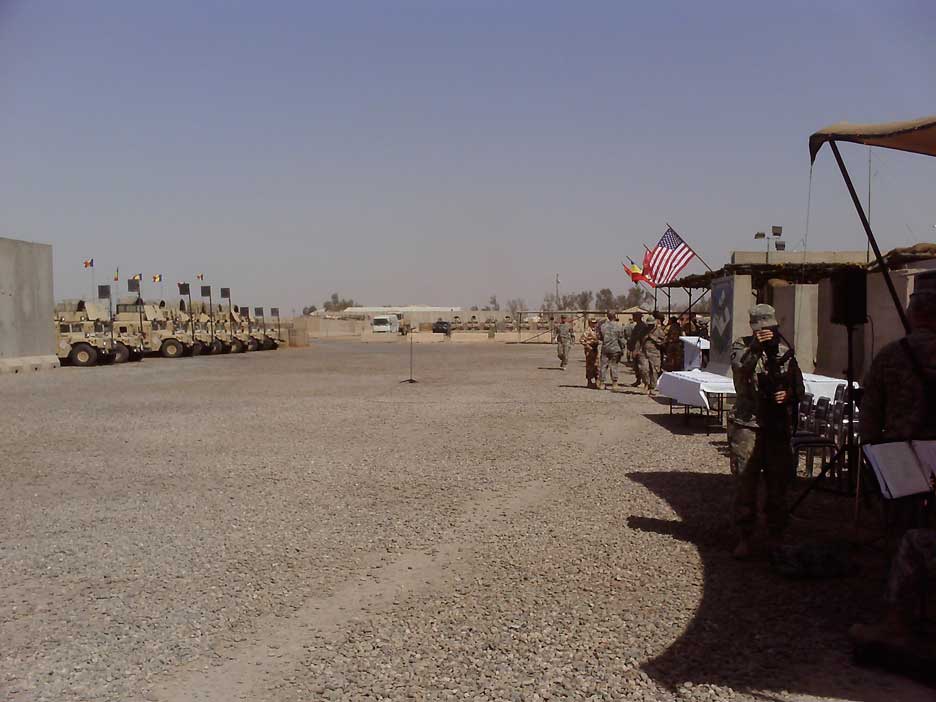By Joseph Giordono, Stars and Stripes
European edition, Sunday, March 23, 2003

Talil Airbase
By Joseph Giordono, Stars and Stripes
European edition, Sunday, March 23, 2003
Joseph Giordono / S&S
It was a well-executed mission: An American combat brigade swooped out of the desert at night, pouncing on key strategic targets near An Nasiriyah.
In short order, the brigade secured a bridge across the Euphrates, destroyed an Iraqi infantry division garrison and claimed a key airfield.
Then someone got shot.
As the sun rose Saturday morning, 3rd Infantry Division soldiers out of the 1st Battalion, 15th Infantry Regiment had just completed a whirlwind 24 hours. They had crossed the border with no opposition, then endured a frustrating speed-run through the southern deserts.
When darkness fell, they attacked the targets.
By morning, members of the regiment's scout platoon and a small number of tanks had secured a road east of the military garrison. Engineers were putting concertina wire across the road, and scouts were standing next to their vehicles, discussing their first night of combat.
A few shots popped off in the distance. Nobody paid much mind.
Then the sky was filled with incoming tracer rounds. Tankers and scouts scrambled back to their vehicles, returning fire at targets on either side of the road less than 100 yards away.
As the firing grew louder, three sharp, sickening screams cut through the noise: An American soldier had been hit.
A few seconds before, the soldier, whose name is being withheld pending family notification, had been smoking a cigarette, comparing notes on the laser-sighting system he used the night before to help kill three Iraqi tanks.
Sabre One Golf is hit! Sabre One Golf is hit! was called over the radio, referring to the soldier's call sign. A fellow soldier grabbed the wounded soldier and dragged him behind an armored Humvee. As they waited for help, Capt. Scott Brannon, the scout platoon commander, stood in front of his wounded soldier, putting his own body between the firing enemy and the soldier, who was bleeding through his stomach and back.
Minutes later, an armored medic track pulled up to the fallen soldier and rushed him away.
For the next 45 minutes, the ambush continued. Three American tanks, two Humvees and a handful of Bradleys returned fire, sending up huge puffs of smoke and dust.
Sporadic enemy mortar and artillery fire continued on the road, which marked the outside boundary of Objective Liberty, the Iraqi garrison.
Later, news came across the radio that the soldier was in stable condition; the round had passed through his abdomen and exited through his back.
The resistance may have come as a bit of a surprise to the soldiers.
Before the fight, battalion commander Lt. Col. John Charlton had suggested that most of the Iraqi troops in the region were ready to surrender.
We don't know if we'll see a big fight, a medium fight or a little fight, Charlton said. We're planning for a big fight because we have to.
It was the frightening culmination of a long day that had started at 6 a. m., when elements of the 3rd Brigade Combat Team punched through the border. The euphoria of an early morning, unopposed border crossing quickly faded after several elements got bogged down in an attempted sprint through the desert.
And though long columns of tanks and Bradley fighting vehicles pushed steadily forward, the support trains Ñ fuel trucks, 5-tons and some Humvees Ñ foundered in the deep desert sand.
This Task Force won't be going too far without the fuel trucks, said Brannon.
Brannon's group is augmented with a company of M1A1 Abrams tanks, making it Task Force 1-15. Other elements from the 3rd Brigade Combat Team, of which Task Force 1-15 is part, faced similar problems heading north.
All afternoon Friday, scattered groups of vehicles were calling for help from wreckers and anyone else who could give a hand.
The only Iraqis that most of the troops saw were desert dwellers and sheep herders Ñ oddly appropriate since the scout platoon spent most of the day rounding up wayward units and marking the location of stranded vehicles on global positioning systems.
Even the division's commander had his troubles. One scout vehicle came across the support vehicles for Maj. Gen. Buford Blount, the commander of the 3rd Infantry Division. Blount had presumably moved along, but the vehicle crews sat atop their tracks, watching the rest of the columns move past.
After this morning, this is a bit of a change, said Sgt. Joshua Snow, a 24-year-old scout from Beaverton, Mich. There are vehicles all over the place.
Before sunrise on Friday, the 1st Battalion finally did what it had been waiting more than 200 days to do: breach the Iraqi border.
As the night sky started to lighten, two long columns of vehicles passed through holes punched by combat engineers. There was no sign of opposition. A long night of artillery shelling and MLR launches wiped out any border guards who had not already surrendered.
When the vehicles passed through the wide demilitarized zone, they were greeted by a simple, hand-painted wooden sign posted by the engineers who had cleared the lane: Welcome to Iraq
 >
>